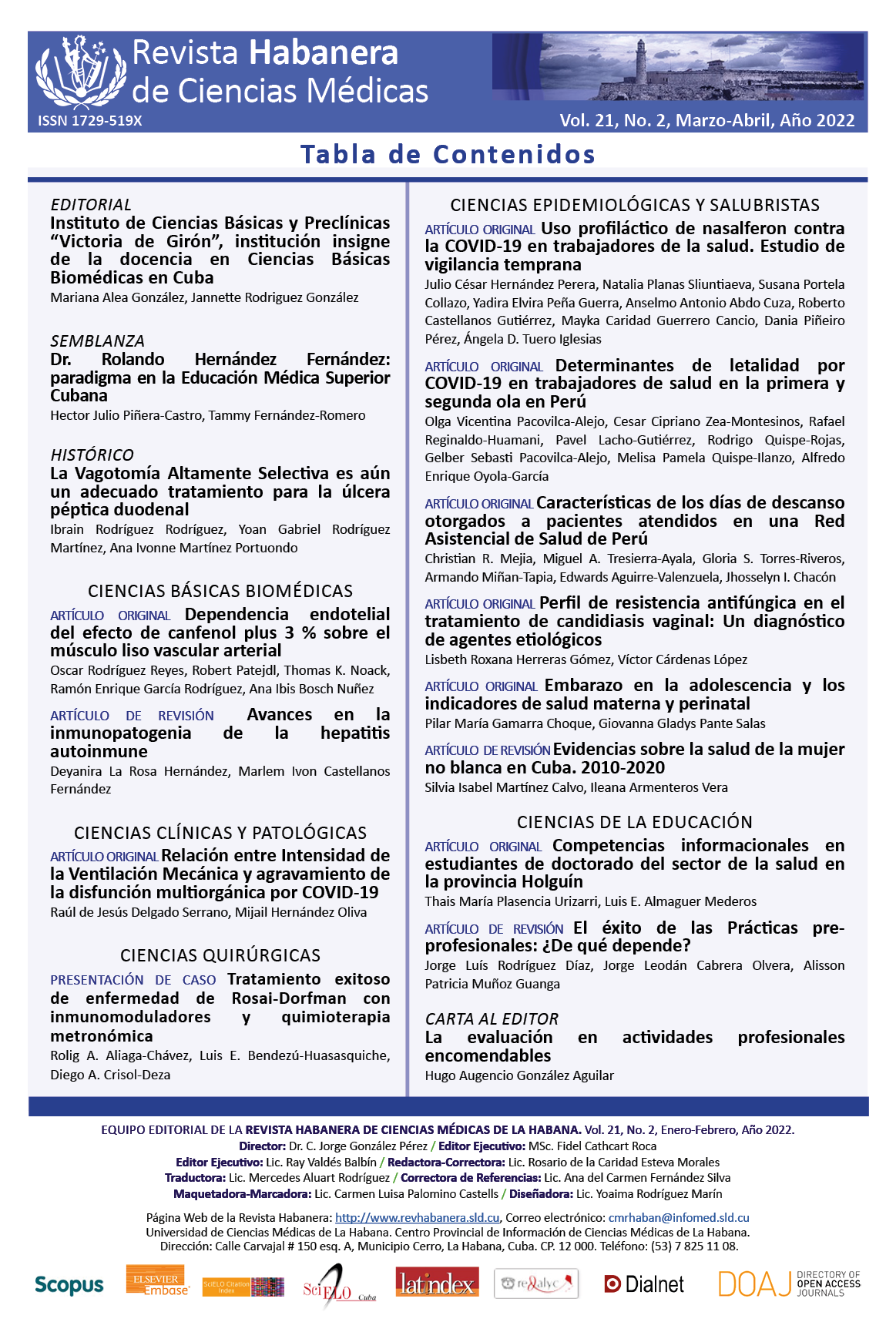Endothelial dependence of the effect of 3% camphenol plus on arterial vascular smooth muscle
Keywords:
vasodilation, vascular smooth muscle, muscle tension, acetylcholine, camphorated parachlorophenol.Abstract
Introduction: Camphenol plus is a chlorinated phenol derivative commonly used as intracanal medication during pulporradicular treatments in Dentistry. Studies in relation to its effects on arterial vascular smooth muscle and the involvement of the endothelium in them are scarce.
Objective: To determine the endothelial dependence of the effect of 3 % camphenol plus on arterial vascular smooth muscle.
Material and Methods: A preclinical experimental research was carried out using 26 external carotid artery rings devoid of vascular endothelium. The preparations made were placed in an organ bath, recording the tension developed by the vascular smooth muscle after the addition of acetylcholine, as well as 3 % Camphenol plus solutions during different intervals of time. The dependence between both tensions was determined through a simple linear regression model.
Results: After pre-activation with Krebs concentrated potassium ion solution, the addition of 10 μl of acetylcholine and 3 % camphenol plus induced a discrete but significant vasorelaxation of the vascular smooth muscle. The linear regression model developed demonstrated the dependence between the variables tension produced by acetylcholine and tension produced by the drug at the tenth minute, corroborating the involvement of the vascular endothelium in that vasorelaxant effect.
Conclusions: It is concluded that 3 % Camphenol plus in vitro, produced a vasorelaxant effect on the smooth muscle of external carotid rings dependent on endothelium and from a relaxing or hiperpolarizing factor derived from it.Downloads
References
1. Drugbank Online. Paraclorofenol [Internet]. Vancouver: Educe Design & Innovation Inc; 2016 [Citado 24/11/2020]. Disponible en: https://go.drugbank.com/drugs/DB13154
2. Rodríguez Guerrero ME. Estudio comparativo in vitro del efecto antibacteriano entre tres sustancias utilizadas como medicamento intraconducto contra cepas de Enterococus faecalis [Tesis Especialidad Odontología]. Ecuador: Universidad Nacional de Loja; 2018 [Citado 24/11/2020]. Disponible en: https://dspace.unl.edu.ec/jspui/bitstream/123456789/20688/1/Tesis%20Marlon%20Rodriguez%20Guerrero.pdf
3. Pedraza Maquera KI. Medicación intraconducto frente al Enterococcus faecalis. Revista Odontológica Basadrina [Internet]. 2019 [Citado 24/11/2020];3(2):49-55. Disponible en: http://revistas.unjbg.edu.pe/index.php/rob/article/view/893
4. Himadri P, Arpita S, Lopamoodra D, Subrahata H, Subir S. Application of Intracanal Medicaments: A Review. IOSR Journal of Dental and Medical Sciences [Internet]. 2019 [Citado 24/11/2020];18(1):14-21. Disponible en: https://iosrjournals.org/iosr-jdms/papers/Vol18-issue1/Version-3/B1801031421.pdf
5. Canalda C. Medicación intraconducto. En: Canalda C, Brau E. Endodoncia. Técnicas clínicas y Bases científicas [Internet]. España: Editorial Masson; 2019.p.184-93 [Citado 24/11/2020]. Disponible en: https://booksmedicos.org/endodoncia-tecnicas-clinicas-y-bases-cientificas/#more-139329
6. Rincón Silva NG, Moreno Piraján JC, Giraldo L. Remoción de fenol, p-nitrofenol y p-clorofenol desde carbones activados químicamente con ácido sulfúrico desde material lignocelulosico de desecho: efecto de la concentración del agente activante. Afinidad [Internet]. 2017 [Citado 24/11/2020];74(578):112-123. Disponible en: https://www.raco.cat/index.php/afinidad/article/view/326513
7. Low AM, Sormaz L, Kwan CY, Daniel EE. Actions of 4‐chloro‐3‐ethyl phenol on internal Ca2+ stores in vascular smooth muscle and endothelial cells. British Journal of Pharmacology [Internet]. 2009;122(3):504-10. Disponible en: https://doi.org/10.1038/sj.bjp.0701389
8. Goss Sampson MA. Análisis estadístico con JASP: una guía para estudiantes [Internet]. Barcelona: Universitat Oberta de Catalunya; 2019 [Citado 18/03/2021]. Disponible en: http://openaccess.uoc.edu/webapps/o2/bitstream/10609/102926/6/An%C3%A1lisis%20estad%C3%ADstico%20con%20JASP%20una%20gu%C3%ADa%20para%20estudiantes.pdf
9. Marcelo Campos D. Óxido Nítrico. Fisiología y Farmacología. Rev Arg Anest [Internet]. 2001 [Citado 18/03/2021];59(4):297-303. Disponible en: https://www.anestesia.org.ar/search/articulos_completos/1/1/230/c.pdf
10. Brown JH, Brandl K, Wess J. Agonistas y antagonistas del receptor muscarínico. En: Brunton LL, Hilal Dandan R, Knollmann BC. Godman & Gilman. Las bases farmacológicas de la terapéutica. 13 ed [Internet]. Mexico: Editorial McGraw Hill Interamericana; 2019.p. 149-50 [Citado 18/03/2021] Disponible en: https://booksmedicos.org/goodman-gilman-las-bases-farmacologicas-de-la-terapeutica-13a-edicion/#more-136377
11. Flórez J. Farmacología general del sistema nervioso autónomo. En: Flórez J, Armijo JA, Mediavilla A. Farmacología Humana. 6 ed [Internet]. Barcelona: Editorial Elsevier Masson; 2014.p.220 [Citado 18/03/2021]. Disponible en: https://booksmedicos.org/farmacologia-humana-5a-edicion-jesus-flores/#more-50295
12. Paredes Carbajal MC, Ramírez Rosas E, Cervantes Hernández I, Verdugo Díaz L, Torres Durán PV, Juárez Oropeza MA. Relación entre la disfunción endotelial y el estrés mental. Revista de Educación Bioquímica [Internet]. 2020 [Citado 18/03/2021];39(1):3-13. Disponible en: https://www.medigraphic.com/cgi-bin/new/resumen.cgi?IDARTICULO=93155
13. Carvajal Carvajal C. El endotelio: estructura, función y disfunción endotelial. Med Leg Costa Rica [Internet]. 2017 [Citado 18/03/2021];34(2).Disponible en: https://www.scielo.sa.cr/scielo.php?script=sci_arttext&pid=S140900152017000200090
14. Garland CJ, Dora KA. EDH: hiperpolarización dependiente del endotelio y señalización microvascular. Acta Physiologica [Internet]. 2017;219(1):152-61. Disponible en: https://doi.org/10.1111/apha.12649
15. Vives Guerrero C. Papel biológico del óxido nítrico [Tesis Especialidad]. España: Universidad Complutense; 2018 [Citado 18/03/2021]. Disponible en: http://147.96.70.122/Web/TFG/TFG/Memoria/CARLOS%20VIVES%20GUERRERO.pdf
16. Fernández Agudelo S, Zeledón Corrales N, Rojas Jara A. Rol del óxido nítrico en la fisiopatología del ictus cerebral. Revista Médica Sinergia [Internet]. 2020 [Citado 21/03/2021];5(1):[Aprox. 2 p]. Disponible en: https://revistamedicasinergia.com/index.php/rms/article/download/339/707?inline=1
17. Prieto Ocejo D. Reactive oxygen species: role in vascular function and in metabolic disease-associated endothelial dysfunction. An Real Acad Farm [Internet]. 2019 [Citado 18/03/2021];89(4):288-300. Disponible en: https://www.researchgate.net/publication/346966600_Reactive_oxygen_species_role_in_vascular_function_and_in_metabolic_disease-associated_endothelial_dysfunction
18. Syed AU, Thanhmai L, Navedo MF, Nieves Cintrón M. Canales iónicos y su regulación [Internet]. London: IntechOpen; 2019. Disponible en: http://doi.org/10.5772/intechopen.88962
19. Bergantin LB. The Control of Vascular Smooth Muscle Tone: Concepts Coming from Ca2+ and cAMP Signalling. J Thrombo Cir [Internet]. 2018 [Citado 05/09/2020];4:1000e111. Disponible en: https://www.longdom.org/open-access/the-control-of-vascular-smooth-muscle-tone-concepts-coming-fromca2-and-camp-signalling-2572-9462-1000e111.pdf
20. Aiello EA. Canales de potasio y calcio en el músculo liso vascular. En su: Hipertensión arterial, epidemiología, fisiología, fisiopatología, diagnóstico y terapéutica [Internet]. Argentina: Sociedad Argentina de Hipertensión Arterial; 2017.p.85-92 [Citado 05/09/2020]. Disponible en: http://www.saha.org.ar/pdf/libro/Cap.019.pdf



